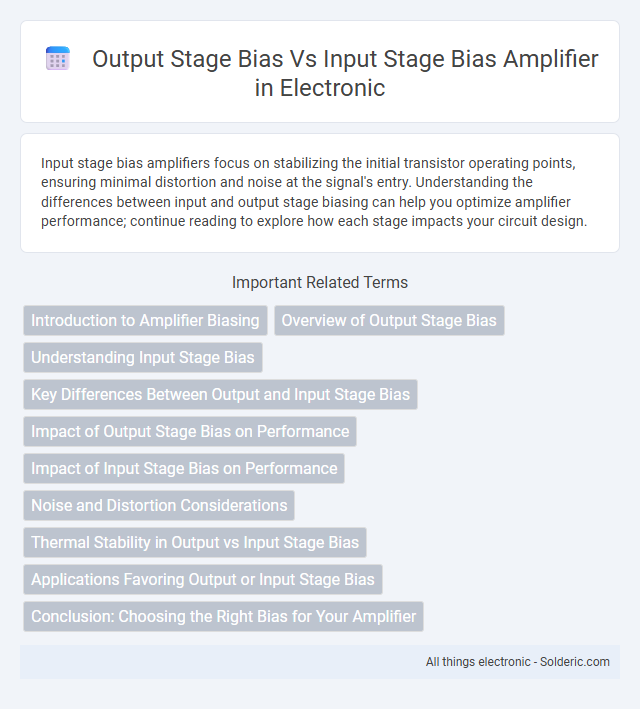Input stage bias amplifiers focus on stabilizing the initial transistor operating points, ensuring minimal distortion and noise at the signal's entry. Understanding the differences between input and output stage biasing can help you optimize amplifier performance; continue reading to explore how each stage impacts your circuit design.
Comparison Table
| Feature | Output Stage Bias Amplifier | Input Stage Bias Amplifier |
|---|---|---|
| Bias Location | Bias applied at the output stage transistors. | Bias applied at the input stage transistors. |
| Thermal Stability | Generally less stable due to higher power dissipation at output. | Better thermal stability with low noise and drift. |
| Noise Performance | Higher noise level due to output stage biasing. | Lower noise; crucial for sensitive input signals. |
| Power Consumption | Higher power consumption owing to biasing high current output transistors. | Lower power consumption at input stage. |
| Linearity | Improves linearity of output transistors. | Improves input signal fidelity and reduces distortion early. |
| Complexity | Biasing circuitry usually more complex due to high current requirements. | Simpler biasing network. |
| Use Cases | Power amplifiers, Class AB output stages. | Low-noise preamplifiers, precision amplifiers. |
Introduction to Amplifier Biasing
Amplifier biasing establishes a stable operating point for transistors, with input stage bias focusing on setting the initial transistor's quiescent current to ensure low distortion and high linearity. Output stage bias controls the bias point of output transistors to minimize crossover distortion and improve power efficiency in class AB amplifiers. Your choice between input stage bias and output stage bias impacts overall amplifier performance, stability, and sound quality.
Overview of Output Stage Bias
Output stage bias in amplifiers stabilizes the operating point of the power transistors to minimize distortion and improve linearity during signal amplification. It ensures that the output transistors conduct appropriately within their active region, reducing crossover distortion commonly seen in Class B amplifier configurations. Your amplifier's performance and efficiency largely depend on precise output stage biasing to maintain signal fidelity.
Understanding Input Stage Bias
Input stage bias in amplifiers ensures stable operation by setting the proper operating point for transistors or other active components, minimizing distortion and noise at the initial signal amplification. It directly affects the linearity and input impedance, which are crucial for preserving signal integrity and preventing loading effects on your source. Proper understanding of input stage bias helps optimize amplifier performance by maintaining consistent gain and reducing crossover distortion in subsequent stages.
Key Differences Between Output and Input Stage Bias
Output stage bias in amplifiers primarily manages the quiescent current flowing through the output transistors to minimize distortion and thermal runaway, ensuring stable power delivery to the load. Input stage bias, however, sets the operating point of the input transistors to maintain linearity and high gain while reducing noise and offset voltage. Key differences include the output bias's focus on power handling and thermal stability versus the input bias's emphasis on signal integrity and low-level signal amplification.
Impact of Output Stage Bias on Performance
Output stage bias directly influences amplifier linearity and thermal stability, reducing crossover distortion and enhancing overall signal fidelity. Precise biasing in the output stage minimizes quiescent current fluctuations, which improves efficiency and extends device longevity. Your amplifier's sound quality and power handling benefit significantly from optimized output stage bias compared to input stage bias configurations.
Impact of Input Stage Bias on Performance
Input stage bias critically influences the linearity and noise levels of an amplifier by stabilizing the transistor operating point, ensuring minimal distortion and improved signal fidelity. Proper input stage biasing enhances input impedance and frequency response accuracy, directly affecting the overall amplification quality. In contrast, output stage bias primarily controls quiescent current to reduce crossover distortion but has less impact on initial signal handling and noise characteristics.
Noise and Distortion Considerations
Output stage bias typically reduces distortion by maintaining consistent current flow, resulting in lower crossover distortion and improved linearity in your amplifier. Input stage bias, while crucial for setting the initial operating point, can introduce more noise due to the higher sensitivity of the input transistors and their susceptibility to thermal and flicker noise. Careful bias optimization at both stages is essential to balance noise performance and distortion, ensuring clear and accurate sound reproduction.
Thermal Stability in Output vs Input Stage Bias
Thermal stability in output stage bias is generally superior due to its direct control over output transistor operating points, minimizing thermal runaway risks under high current conditions. Conversely, input stage bias tends to be more sensitive to temperature variations since input transistors operate with low currents and voltages, making their quiescent current more susceptible to thermal drift. Effective biasing circuits incorporate temperature compensation elements such as diode-connected transistors or thermistors to enhance stability in both biasing stages.
Applications Favoring Output or Input Stage Bias
Output stage bias amplifiers excel in high-power audio and RF applications where thermal stability and linearity at the output transistor are critical for minimizing distortion under varying loads. Input stage bias amplifiers are favored in low-noise, high-gain instrumentation and sensor circuits, providing better control over input offset voltage and improving overall signal fidelity. Your choice depends on whether your design prioritizes output stage thermal management or input signal accuracy.
Conclusion: Choosing the Right Bias for Your Amplifier
Output stage bias provides better thermal stability and reduces crossover distortion, making it ideal for high-power and high-fidelity applications. Input stage bias, while simpler and more energy-efficient, may introduce signal distortion and is typically suited for low-power or low-noise scenarios. Your amplifier's intended use and performance requirements will determine the optimal biasing approach for achieving peak audio quality and efficiency.
output stage bias vs input stage bias amplifier Infographic

 solderic.com
solderic.com